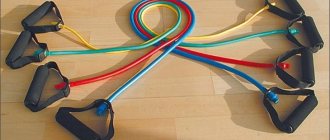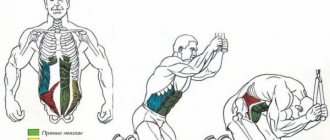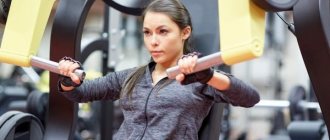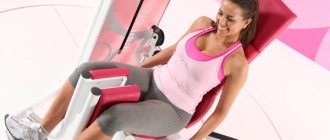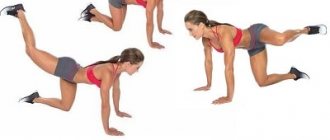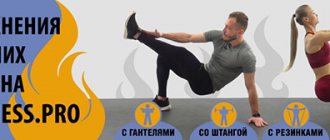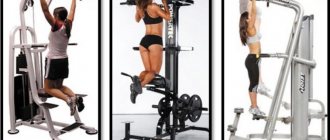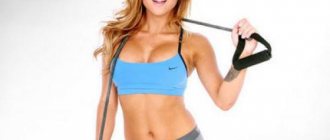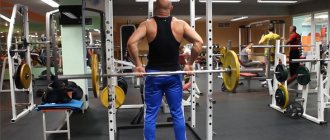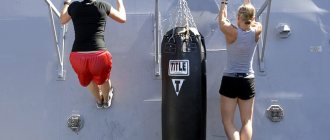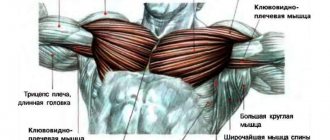Pumping up your chest in a crossover is the choice of bodybuilders and people involved in fitness. Strength training guru for sports Alvin Cosgrow gives only corrective and warm-up exercises in this machine. The expert is sure that no angles, muscle stretches, and other “tricks” that fitness magazines love to regale us with can replace a good bench press for gaining muscle mass. Why do builders love crossovers? When the mass has already been gained, there are no special goals in strength sports, the time comes for muscle isolating training. In the simulator you can work out the pecs with minimal load on the front deltoids, and completely “turn off” the triceps. Moreover, the movements will not be as energy-intensive as the bench press, and will have little effect on the athlete’s appetite. The latter is the main reason why ordinary healthy lifestyle lovers love the crossover. If you combine basic and isolation exercises in your training plan, you can achieve both mass gain and keeping your muscles “dry.”
Crossover chest exercises
Biomechanically, all chest exercises are divided into:
- Bringing your arms together in front of you while standing, lying down, bending over, or on your knees;
- Forward presses while standing with your back to the handle mount
The latter option is often used in functional training, when the goal is to balance the work of the core muscles of an athlete who has scoliosis or poor posture. “People” usually divide exercises according to the level of attachment of the handles.
Bodybuilders tend to overestimate the role of isolation exercises, while strength athletes tend to underestimate it. The first ones write that “a feeling of burning and stretching” of the muscle is a sure sign that the pecs will grow. The second reminds that the chest works best at the start of the bench press, and everything else is just auxiliary exercises.
Important : predominant training of some muscle bundles, angles of the body, “feeling the muscles” will not help to gain mass in the pectorals. If a person has a deficiency of muscle mass, his first exercise is a bench press or dumbbell bench press. Information in the crossover is the last exercise of the chest workout, the goal is to complete it with minimal weight. Elimination of pressing movements is possible only if the athlete has an injury that does not allow him to press.
Benefits of Exercise
Let's look at what bringing hands together in a crossover gives:
- This is one of the highest quality isolated exercises for working the chest.
- The back is not pressed against the bench, as, for example, during a bench press, which reduces the load on it.
- The chest muscles are well stretched, this saturates them with oxygen. At a young age, this allows the diaphragm to expand.
- The load is present at all stages of the exercise - when you bring your arms together and when you spread your arms - the pectoral muscles actively work at each point.
- This exercise shapes and refines the contours of the chest, making them more aesthetically correct.
- Variability allows you to load different areas of the pectoral muscles.
Reduction of hands in a crossover with upper placement of handles
Starting position : secure the handles so that you can grab the handles by stretching your arms up and to the sides, standing straight, and maintaining a forward tilt of the body about 30 degrees from the axis of the spine.
Movement:
- Bring your shoulder blades toward your spine and rotate your shoulders;
- With a conscious effort, contract the pectoralis major muscles;
- At the same time, press your palms onto the handles;
- Bring your hands together in front of you;
- The handles move along an elliptical path;
- Stop – below in the groin area;
- Here, statically tighten your pecs;
- Come back smoothly
Working muscles : pectoralis major as the primary motor, pectoralis minor are involved in the breathing process, serratus – adduct the shoulder blades
In the bodybuilding community, the movement is considered to be targeted at working out the “bottom” of the chest.
TECHNIQUE
Having taken the correct position, bend your elbows slightly, take a deep breath and, using the strength of your arm muscles, bring the upper blocks down at waist level
(the movement should resemble that you are pulling your arms down to hug the girl by the hips).
At the lowest point, additionally tighten your chest muscles and hold in this position for 2 seconds, then relax your arms and return the handle of the exercise machine to the upper position. Do not forget to breathe during the entire movement, lowering the handle down - exhale, moving them up - inhale.
Standing abduction with handles attached at midline chest level
Starting position: the handles are attached to a line that passes through the athlete’s nipples. Further work resembles training in a butterfly simulator. You need to stand straight, your spine perpendicular to the floor, your arms spread to the sides, but not beyond the midline of your body.
Movement:
- Bring your shoulder blades in, move your shoulders away from your ears, secure;
- Start contraction by tensing the chest muscles;
- Keep your arms slightly bent at the elbows, but not completely bent;
- Bring the arms together in front of you, on the midline of the chest;
- Hold the tension statically for 3 seconds;
- Extend your arms to the sides and repeat
Working muscles : predominantly pectoralis major and serratus, in this exercise more load falls on the abs, buttocks and legs, since the body must be stabilized and kept straight. The movement also involves the anterior deltoid muscles.
The exercise is considered to develop the middle tufts of the chest and “lift the chest.”
Description of the exercise
First of all, it can be noted that there are several varieties of this exercise that allow you to work the pectoral muscles. By varying the technique, you can focus the load on the middle, lower or upper chest area.
The exercise is isolated, which means that almost the entire load falls on the pectoral muscles, so it is best to perform this exercise at the end of the workout after basic exercises such as presses, push-ups, pull-ups, and so on.
The biceps, triceps and anterior deltoids are synergists, but the tension in these muscles is minimal if you do it correctly. If you still understand that both biceps and shoulders are very actively involved in the exercise and get tired, reduce the weight. Isolation exercises are done to “finish off”; there is no need to use heavy weights, since this will not lead to significant muscle growth.
If the exercise is performed standing, then the legs, abs and back act as stabilizers. If you need to exclude them, choose the option on the bench.
The difficulty of the exercise lies in the fact that many people pull a very large part of the load with their biceps
Bringing your hands together in a crossover with a lower handle mount
Starting position: almost anyone should lower the clamps to the lowest position; if the athlete is less than 160 cm tall, it makes sense for him to stand on the stand. Hands grasp the handles, the stance is symmetrical, performed with a slight tilt forward.
Movement:
- The shoulder blades are stabilized, the shoulders are removed from the ears;
- The shoulders remain stable throughout the movement;
- Hands are brought together in front of the chest, moving the handles from bottom to top;
- The movement is performed smoothly in reverse order
Working muscles : pectoralis major, and anterior deltoids, as well as the serratus muscle
Considered a good option for training the lower pecs.
You are in the section:
Sports and beauty > Exercises for training > Bringing your arms together in a crossover: shocking the pectoral muscles
Good day to all! Today we will look at the exercise of bringing hands together in a crossover , we will analyze the main variations, execution technique and mistakes.
The crossover crossover is an isolated exercise aimed at working the pectoral muscles. In addition to the target muscles, which with the correct technique should receive the lion's share of the load, part of the load is taken by the back, biceps, triceps, deltoids and stabilizer muscles.
I would like to note that this exercise is more suitable for those athletes who already have extensive experience in training and have built up fairly large pectoral muscles. The exercise is more aimed at correcting and giving a certain shape to the pectoral muscles, to draw a clear contour before and for variety of training.
In other words, this exercise will not provide an opportunity to build muscle mass, so for beginners it will only be effective in feeling the target muscles and correctly engaging them in work. That is, this exercise will help improve the neuromuscular connection, the brain-muscle connection.
Variations of hand mixing in crossover
There are several variations of this exercise. Below we will look at each of them and analyze the execution technique.
Bringing your arms in front of you while bending over
This option is designed to evenly distribute the load throughout the chest muscle. Depending on the forward tilt of the body, the distribution of the load changes, that is, the lower the forward tilt, the more the upper pecs are involved in the work; if the body is almost straight, then the emphasis shifts to the lower pectorals.
Typically, this exercise is performed with the body tilted at about 45 degrees, although you can choose for yourself the angle at which you will feel the maximum work of the pecs.
Execution technique
Place the crossover blocks in the upper position, grab the handles and stand strictly in the center of the machine. Place your feet shoulder-width apart, bend your knees, and lean your body slightly forward. Bring your arms together in the chest area, while making sure that your arms are slightly bent at the elbows. This is the starting position.
As you inhale, filling your chest with air, smoothly and concentrating on the target muscles, spread your arms to the side, feeling the stretching of the muscles. As you exhale, including your chest muscles, bring your arms together in front of you and hold the peak contraction for 1 to 2 seconds, contracting your pectoral muscles as much as possible.
Reduction of arms in a crossover to work the lower pectoral muscles
The difference from the previous exercise is that the arms are brought together at the level of the lower abdomen. Thus, it is the lower part of the pectoral muscles that is well involved in the work. The blocks in this case are also fixed at the top point.
Make sure that the torso always remains motionless, the back is arched with a natural deflection in the lower back, and the arms move in the same plane at an angle to the torso.
Removing hands from the lower block
In this case, the emphasis is on working the upper part of the pectoral muscles, part of the load falls on the front deltas.
Execution technique
Place the crossover blocks in the lower position, set the required weight and grab the handles. Feet are shoulder-width apart and in line, back straight. Spread your chest slightly forward and move your shoulders back. Your arms should be slightly bent at the elbows. This is the starting position.
As you exhale, including your chest muscles, raise and bring your arms together in front of you, contracting the muscles as much as possible at the top point. Fix for 1-2 seconds in this position and then, while inhaling, smoothly and under control lower your arms to the starting position. At the same time, make sure that the body is always fixed, both when bringing and lowering your arms. At the top point, your elbows should be facing the floor and your palms should be turned up. In this case, the muscles will receive maximum contraction.
Reduction of hands in a crossover while lying on a bench
This exercise is analogous to dumbbell flyes while lying on a bench. It can be performed either on a horizontal bench, or on an inclined bench with your head up, or on a bench with a negative inclination angle. By changing the angle of inclination, you can target a specific part of the pectoral muscles.
Execution technique
Place the bench exactly in the center of the machine. Place the crossover blocks in the lower position and, holding the handles, carefully lie down on the bench. When positioned correctly, the crossover handles should be at shoulder level.
The head, upper back and buttocks are located on the bench; there should be a slight deflection in the lower back. The shoulder blades are brought together, and the legs are spread apart and feet firmly on the floor. The arms are spread apart and slightly bent at the elbows. This is the starting position. As you exhale, including the chest muscles, bring your arms together, take a short pause, contracting the target muscles as much as possible. As you inhale, gently lower your arms, feeling the chest muscles stretch.
Basic mistakes
- Very often you can hear advice where it is recommended to put one of your legs forward to stabilize the body. But you must admit that in this case an imbalance of the body occurs, which leads to different loads. To ensure that the load is distributed symmetrically, always make sure that your feet are on the same line;
- There is no need to work with heavy weights, the task is to reach the target muscles and feel the stretch when raising and the contraction when bringing your arms together;
- To avoid injuring your elbow joints, never fully straighten your arms. Do not forget that your arms should be slightly bent at the elbows throughout the exercise;
- Although Cheating is considered acceptable in other exercises, when performing this exercise there should be no jerks, failures, or nervous tics. All movements are performed smoothly and under control;
- Even if you want to look at the reactions of others, you do not need to rotate your head in different directions while performing the exercise. The gaze should be directed in front of you to avoid various pinching and injuries. If unconscious head nods occur during execution, then simply reduce the weight and perform the exercise correctly;
- There is no need to suddenly drop the weight at the start, otherwise you simply cannot avoid a shoulder injury. Do not forget that all movements are performed smoothly; if you want to start the reduction with a jerk, then perhaps you have gone too far with the weight.
Video: Bringing hands together in crossover
Recommendations
- Since the crossover crossover is considered an isolated exercise, perform it after the main compound exercises at the end of the workout;
- You can work the central part of the pectoral muscles by lowering the blocks to chest level, that is, the exercise is similar to dumbbell flyes on a horizontal bench, bring your arms together at chest level;
- To stretch the chest muscles as much as possible, you should find the optimal position. For each athlete it can be different, based on physiological characteristics. Therefore, find the desired position in the crossover, located further or closer to the block fastening line;
- Make sure that the body is fixed, the movement is performed only in the shoulder joint. There is no need to help yourself with your body or back, rounding it, otherwise there is a risk of injury;
- Even if this exercise is the last one in training the pectoral muscles and thus at the end you have stretched them well, do not be lazy and do a cool-down.
Crossover mixing with different body angles
Vertical body position
This version of the initial position is used both for mixing with the upper, middle and lower positions of the handles. The basic mixing technique does not change. The almost complete absence of tilt makes the shoulders more stable and their range of motion more natural. This option is indicated for athletes with shoulder injuries and anterior deltoid overloaded from the bench press.
Slight forward lean
A slight inclination allows you to deepen the stretch of the pectoral muscles and work them out more efficiently with lighter weights. Used in training beginners, legs can be placed either in straddle or in parallel. An important condition is not to change the angle of the body.
Tilt forward 90 degrees
This is an extreme option used in bodybuilding. It gives maximum stretch to the pectoralis major muscle, but involves the entire upper body, and is quite risky for the shoulder joint. This option is not used in fitness, and is not recommended for independent development due to the risk of injury.
Benefits and contraindications
Before moving on to the story about the technique of performing the exercise, we will briefly describe what advantages and benefits it gives the athlete, as well as to whom its implementation is contraindicated and for what reasons.
Benefits of exercise
With the help of hand movements in a crossover, you can make a huge leap in the development of the pectoral muscles. It is ideal for learning how to “turn on” them correctly, since the work is isolated, the shoulders and triceps are practically excluded from the movement, which cannot be said about other chest exercises.
As a rule, crossover exercises are placed towards the end of the chest workout to achieve maximum blood flow. The work is carried out in a wide range of repetitions - from 12 and above. The working weight is not particularly important; it is much more important to feel the stretch and contraction of the pectoral muscles.
© zamuruev — stock.adobe.com
Contraindications for performing the exercise
It is not recommended to perform crossover exercises while lying down for athletes who have the following diseases:
- brachial nerve neuritis;
- tendobursitis;
- tendinitis.
Stretching the pectoral muscles too much at the bottom will overstrain the shoulder joints and ligaments, and chronic pain will be felt much more intensely. This applies less to the classic crossover while standing through the upper blocks, but you still need to be careful not to use excessively heavy working weights.
Beginners are not recommended to crossover their arms through lower blocks. This is a very difficult exercise from a technical point of view, requiring an unreal neuromuscular connection. Newbies simply don't have this. Develop your upper chest better with incline presses and flyes, and when you notice an increase in muscle mass, you can smoothly begin performing crossover crossover exercises.
Mixing on a crossover in different racks
Information in all three mounting options is performed while standing in two possible positions:
- In a straddle or “scissors” position, take the starting position as for a lunge, the front leg is slightly bent at the knee, the back leg is straight, but stands on a full foot;
- The thighs are parallel to each other, the starting position is achieved by slight flexion at the hip joint
The stand option is chosen depending on how the case is more stable. The main condition is the absence of a forward push with the body during each repetition. The stand itself is not important. If scissors are used, it is advisable to switch legs with each rep to avoid imbalance.
Reduction while lying on a horizontal bench
Starting position: the bench is installed strictly in the middle of the machine, the cables are attached at the bottom. The athlete grabs the handles and sits on the bench. If the resistance is significant, an assistant is used to help move the handles up in front of the chest to the starting position
Technique : the athlete spreads his arms as in a normal dumbbell fly, in one plane along an arcuate path, and brings them back to the chest
Muscles worked : pectoralis major and minor, anterior deltoids, and serratus.
This movement replaces the dumbbell fly, is considered deeper, and allows you to perform drop sets with the help of an assistant who will change the weight.
Mixing on an incline bench
In terms of starting position and execution, the movement is completely identical to the previous one.
The point of using an incline bench is to use additional amplitude to stretch the muscle. In all technical variants, pushing the body, jerking the arms, and changing the angle of the elbow, knee, hip and shoulder joints are prohibited. The movement is performed with little resistance, the goal is to stretch the muscles as much as possible and statically tense them.
